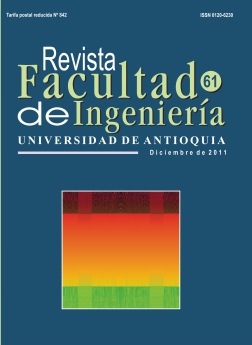Oscillator for Biosensors based on Quartz Crystal Microbalance (QCM)
DOI:
https://doi.org/10.17533/udea.redin.13543Keywords:
oscillator, biosensor, piezoelectric inmunosensor, Carbary, Quartz Crystal Microbalance (QCM)Abstract
Quartz crystal is generally used in some applications as a microbalance taking advantage of its capacity to change the resonance frequency according to any surface mass change on the resonator. In this way a quartz crystal can be used as a transducer in a piezoelectric inmunosensor system in order to detect antigen-antibody bonds.
An interface for Quartz Crystal Microbalances, QCM, based on an improved version of an oscillator in balanced differential configuration and its respective validation as a biosensor characterization system is introduced in this paper. The system was successfully tested in a piezoelectric inmunosensor for detecting the pesticide Carbaryl.
Downloads
References
A. Montoya, A. Ocampo, C. March. “Fundamentals of piezoelectric immunosensors” A. Arnau (editor). Piezoelectric transducers and applications. 2nd ed. Ed. Springer. Berlín (Alemania). 2009. pp. 289-306. DOI: https://doi.org/10.1007/978-3-540-77508-9_12
V. G. Rumayor, E. García Iglesias, O. Ruiz Galán, L. Gago Cabezas. Informe de vigilancia tecnológica: aplicaciones de biosensores en la industria agroalimentaria. Ed. Elecé industria gráfica. Madrid (España). 2005. pp.14-18.
C. March, J. J. Manclús, Y. Jiménez, A. Arnau, A. Montoya. “A piezoelectric immunosensor for the determination of pesticide residues and metabolites in fruit juices” Talanta.Vol. 78. 2009. pp. 827-833. DOI: https://doi.org/10.1016/j.talanta.2008.12.058
J. C. Vidal, P. Duato, L. Bonel, J. R. Castillo. “Use of polyclonal antibodies to ochratoxin A with a quartz-crystal microbalance for developing real-time mycotoxin piezoelectri immunosensors” Anal Bioanal chem. Vol. 394. 2009. pp. 575-582. DOI: https://doi.org/10.1007/s00216-009-2736-6
I. Navrátilová, P. Skládal, V. Viklický. “Development of piezoelectric immunosensors for measurement of almuninuria” Talanta. Vol 55. 2001. pp. 831-839. DOI: https://doi.org/10.1016/S0039-9140(01)00512-4
G. Sauerbrey. “Verwendung von schwingquarzen zur wägung dünner schichten und zur mikrowägung”Z. Phys. Vol. 79. 1959. pp. 206-222. DOI: https://doi.org/10.1007/BF01337937
R. Lucklum, D. Soares, K. Kanazawa. “Models for resonant Sensors”. A. Arnau (editor). Piezoelectric transducers and applications. 2nd ed. Ed. Springer. Berlín (Alemania).2009. pp. 63-96. DOI: https://doi.org/10.1007/978-3-540-77508-9_3
K. K. Kanazawa, J. G. Gordon. “The oscillation frequency of a quartz resonator in contact with a liquid”. Anal Chem. Vol. 57. 1985. pp. 1770- 1771. DOI: https://doi.org/10.1021/ac00285a062
S. J. Martin, V. E. Granstaff, G. C. Frie. “Characterization of a quartz crystal microbalance with simultaneous mass and liquid loading”. Anal. Chem. Vol. 63. 1991. pp. 2272-2281. DOI: https://doi.org/10.1021/ac00020a015
R. Lucklum, P. Hauptmann. “The quartz crystal microbalance: mass sensitivity, viscoelasticity and acoustic amplification”. Sensors and ActuatorsB. Vol. 70. 2000. pp. 30-36. DOI: https://doi.org/10.1016/S0925-4005(00)00550-5
A. Arnau, D. Soares. “Fundamentals of piezoelectricity” A. Arnau (editor). Piezoelectric transducers and applications. 2nd ed. Ed. Springer. Berlín (Alemania). 2009. pp. 1-38. DOI: https://doi.org/10.1007/978-3-540-77508-9_1
A. Arnau, V. Ferrari, D. Soares, H. Perrot. “Interface electronic systems for AT-Cut QCM sensors: A comprehensive review” A. Arnau (editor) Piezoelectric transducers and applications. 2nd ed. Ed. Springer. Berlín (Alemania). 2009. pp. 117-186. DOI: https://doi.org/10.1007/978-3-540-77508-9_5
Y. Montagut, J. García, J. Jiménez, C. March, A. Montoya, A. Arnau. “Validation of a Phase-Mass characterization concept and interface for acoustic biosensors”. Sensors. Vol. 11. 2011. pp. 4702-4720. DOI: https://doi.org/10.3390/s110504702
E. A. Bustabad, G. García, L. Rodriguez Pardo, J. Fariña, H. Perrot, C. Gabrielli, B. Bucur, M. Lazerges, D. Rose, C. Compere, A. Arnau. “A biosensor for detection of DNA squences based on a 50MHz QCM electronic oscillator circuit”. Sensors. 25-28. Octubre. 2009. pp. 687-690. DOI: https://doi.org/10.1109/ICSENS.2009.5398346
E. Benes, M. Gröschl, W. Burger, M. Schmid. “Sensors based on piezoelectric resonators”. Sensors and Actuators A. Vol. 48. 1995. pp. 1-21. DOI: https://doi.org/10.1016/0924-4247(95)00846-2
E. Benes, M. Schmid, M. Gröschl, P. Berlinger, H. Nowotny, K.C. Harms. Solving the cable problem between crystal sensor and electronics by use of a balanced bridge oscillator circuit. Frequency and time forum, 1999 and the IEEE international Frequency Control Symposium, 1999. Proceedings of the 1999 meeting of the European. 2. Besançon (Francia). 13- 16. Abril. 1999. pp. 1023-1026
C. Barnes “Some new concepts on factors influencing the operational frequency of liquid-inmersed quartz microbalances”. Sensors and Actuators A – Physical. Vol. 30. 1992. pp. 197-202 DOI: https://doi.org/10.1016/0924-4247(92)80120-R
A. Abad, J. Primo, A. Montoya. “Development of an enzyme-linked immunosorbent assay to Carbaryl. 1. Antibody production from several haptens and characterization in different immunoassay format”. Journal of agricultural and food chemistry. Vol. 45. 1997. pp. 1486-1494. DOI: https://doi.org/10.1021/jf9506904
Downloads
Published
How to Cite
Issue
Section
License
Copyright (c) 2018 Revista Facultad de Ingeniería

This work is licensed under a Creative Commons Attribution-NonCommercial-ShareAlike 4.0 International License.
Revista Facultad de Ingeniería, Universidad de Antioquia is licensed under the Creative Commons Attribution BY-NC-SA 4.0 license. https://creativecommons.org/licenses/by-nc-sa/4.0/deed.en
You are free to:
Share — copy and redistribute the material in any medium or format
Adapt — remix, transform, and build upon the material
Under the following terms:
Attribution — You must give appropriate credit, provide a link to the license, and indicate if changes were made. You may do so in any reasonable manner, but not in any way that suggests the licensor endorses you or your use.
NonCommercial — You may not use the material for commercial purposes.
ShareAlike — If you remix, transform, or build upon the material, you must distribute your contributions under the same license as the original.
The material published in the journal can be distributed, copied and exhibited by third parties if the respective credits are given to the journal. No commercial benefit can be obtained and derivative works must be under the same license terms as the original work.











 Twitter
Twitter